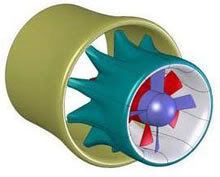More Power From Less Wind

Wind power is currently limited by the fact that there is a minimum wind speed required for a wind turbine to begin operation. We could harvest a lot more energy from the wind if that minimum speed was lower. Plus it would help a lot if the wind passing the turbine was speeded up to make generation more effective. There is a new design for wind turbines which does exactly that.
FloDesign Wind Turbine, a spin-off from the aerospace company FloDesign based in Wilbraham, MA, has developed a wind turbine that could generate electricity at half the cost of conventional turbines. The company recently raised $6 million in its first round of venture financing and has announced partnerships with wind-farm developers.One of the questions that will have to be answered is does the turbine wind up sounding like a jet engine? If so it will limit the places it can be deployed.
The company's design, which draws on technology developed for jet engines, circumvents a fundamental limit to conventional wind turbines. Typically, as wind approaches a turbine, almost half of the air is forced around the blades rather than through them, and the energy in that deflected wind is lost. At best, traditional wind turbines capture only 59.3 percent of the energy in wind, a value called the Betz limit.
FloDesign surrounds its wind-turbine blades with a shroud that directs air through the blades and speeds it up, which increases power production. The new design generates as much power as a conventional wind turbine with blades twice as big in diameter. The smaller blade size and other factors allow the new turbines to be packed closer together than conventional turbines, increasing the amount of power that can be generated per acre of land.
The idea of enshrouding wind-turbine blades isn't new. But earlier designs were too big to be practical, or they didn't perform well, in part because the blades had to be very closely aligned to the direction of the wind--within three or four degrees, says Stanley Kowalski, FloDesign's CEO. The new blades are smaller and can work at angles of up to 15 to 20 degrees away from the direction of the wind.
There are other problems as well. Like how will the rig stand up to 100 mph winds? Still it is a promising development.
H/T Helius at Talk Polywell.
Cross Posted at Classical Values













No comments:
Post a Comment